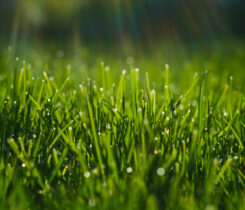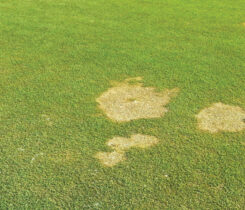Off the Record: USGA’s contributions address environmental issues
In 1983, the USGA Turfgrass Research Program focused on turfgrass stress physiology, breeding, cultural practices and developing the organization’s Turfgrass Information File. By 1987, there were 23 projects underway at 13 universities in the U.S. and one project in New Zealand. The annual budget in 1987 was $480K, with $2.19 million total allocated for 1983 through 1988.
A growing issue by the end of the ’80s was the environmental impact of golf courses, particularly on water quality and wildlife. The research committee invited Stuart Cohen, Ph.D., James Balogh, Ph.D., and William Walker, Ph.D., to summarize the fate of agricultural pesticides and nutrients. Cohen participated in a groundwater monitoring study of pesticides and nitrates associated with courses in Cape Cod.
The Cape Cod study revealed that nitrate-N concentrations in wells were generally below the 10 ppm federal maximum concentration limit (MCL), with some exceptions. However, golf courses were under attack and any bad news, though rare, prevented new course construction.
New Research Focus
As a follow-up to the meeting, the research committee started developing an environmental research program.
The overall objectives were to:
- Understand the effect of turfgrass pest management and fertilization on water quality and the environment,
- Evaluate valid alternative methods of pest control, integrated turf management systems, and
- Determine the human, biological, and environmental factors golf courses influence.
In 1991, the research committee selected 11 pesticide and nutrient fate projects, four environmental benefits projects and six biocontrol projects. The USGA also supported Balogh and Walker in assessing golf’s environmental issues. In 1992, they published their report to the research committee in the book Golf Course Management & Construction — Environmental Issues.
In 1994, researchers presented pesticide and nutrient fate results at Golf House to summarize three years of research and plan for future studies. In 1995, the USGA renamed the Green Section’s research effort Turfgrass and Environmental Research.
In-Depth Look
The Crop Science Society of America published five papers from the “Symposium on Pesticide and Nutrient Fate under Turfgrass Golf Course Conditions” in the November-December 1996 issue of Crop Science. In 1998, the American Chemical Society (ACS) and USGA co-sponsored a symposium at the summer ACS meeting in Boston. John M. Clark, Ph.D., helped coordinate the meeting. ACS published its Symposium Series 743, “Fate and Management of Turfgrass Chemicals,” in 2000.
The first section discusses knowledge, at that time, of environmental issues concerning the USGA, the scope, benefits and makeup of the turfgrass industry with particular emphasis on golf courses, and a review of turfgrass management from an agrochemical viewpoint. Following sections go on to review research on the environmental fate of nutrients and pesticides applied the turfgrass. Seven chemical management strategies for reducing environmental and human exposure are discussed before the final section presents novel biotechnological and alternative (non-chemical) pest management approaches to maintain turfgrass in a less chemically-dependent fashion.
The USGA helped fund proceedings from the January 2006 meeting held by Council for Agricultural Science and Technology (CAST). The CAST Special Publication 27 “Water Quality and Quantity Issues for Turfgrasses in Urban Landscapes” summarizes the USGA research to protect and conserve water.
Most of this research helped develop the Golf Course Superintendents Association of America’s best management practices for all 50 states. I often wonder where golf would be today without the significant contribution the USGA, allied associations, universities and government agencies made to address golf’s environmental issues in the 1980s.

Photo: Mike Kenna, Ph. D.
Mike Kenna, Ph.D., is the retired director of research, USGA Green Section. Contact him at mpkenna@gmail.com.












